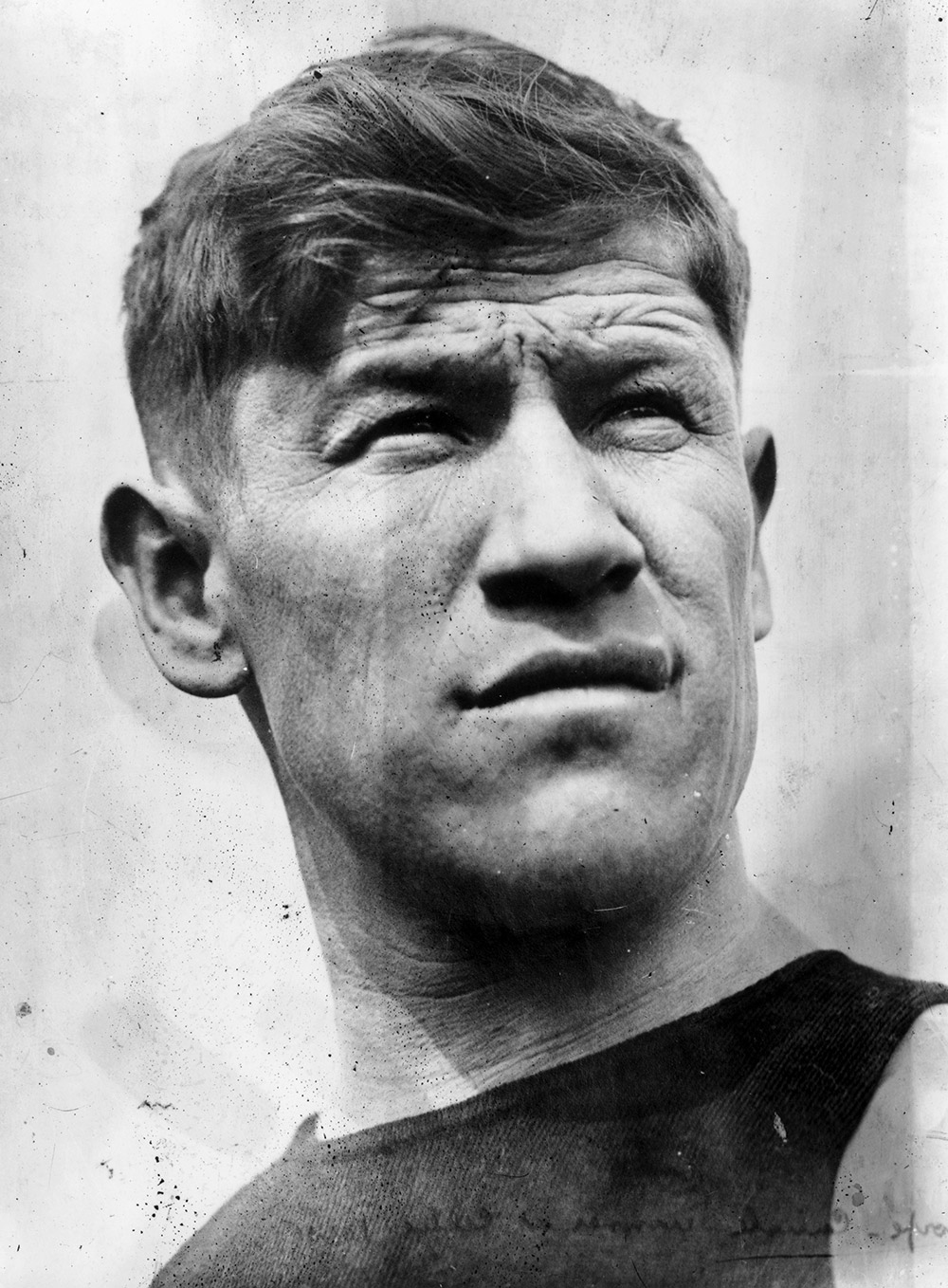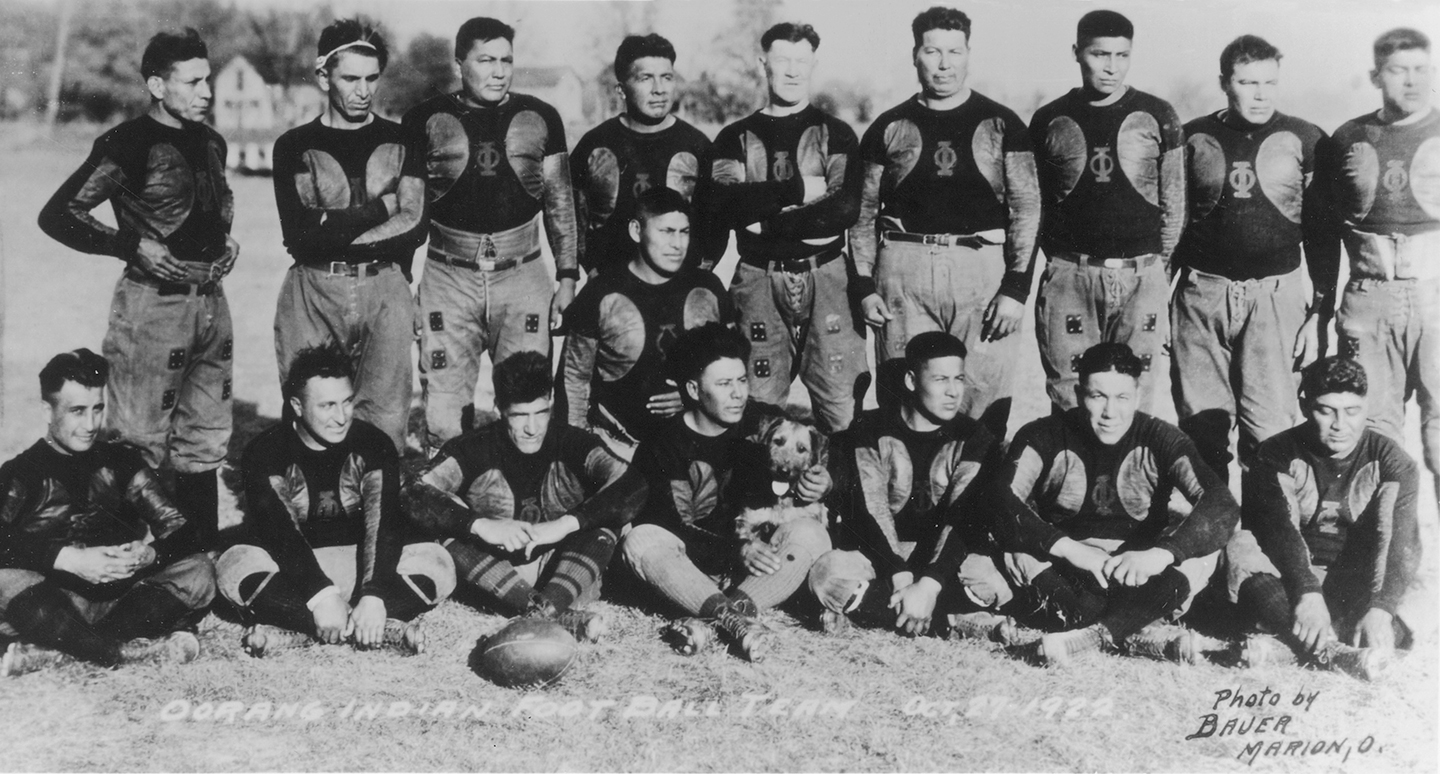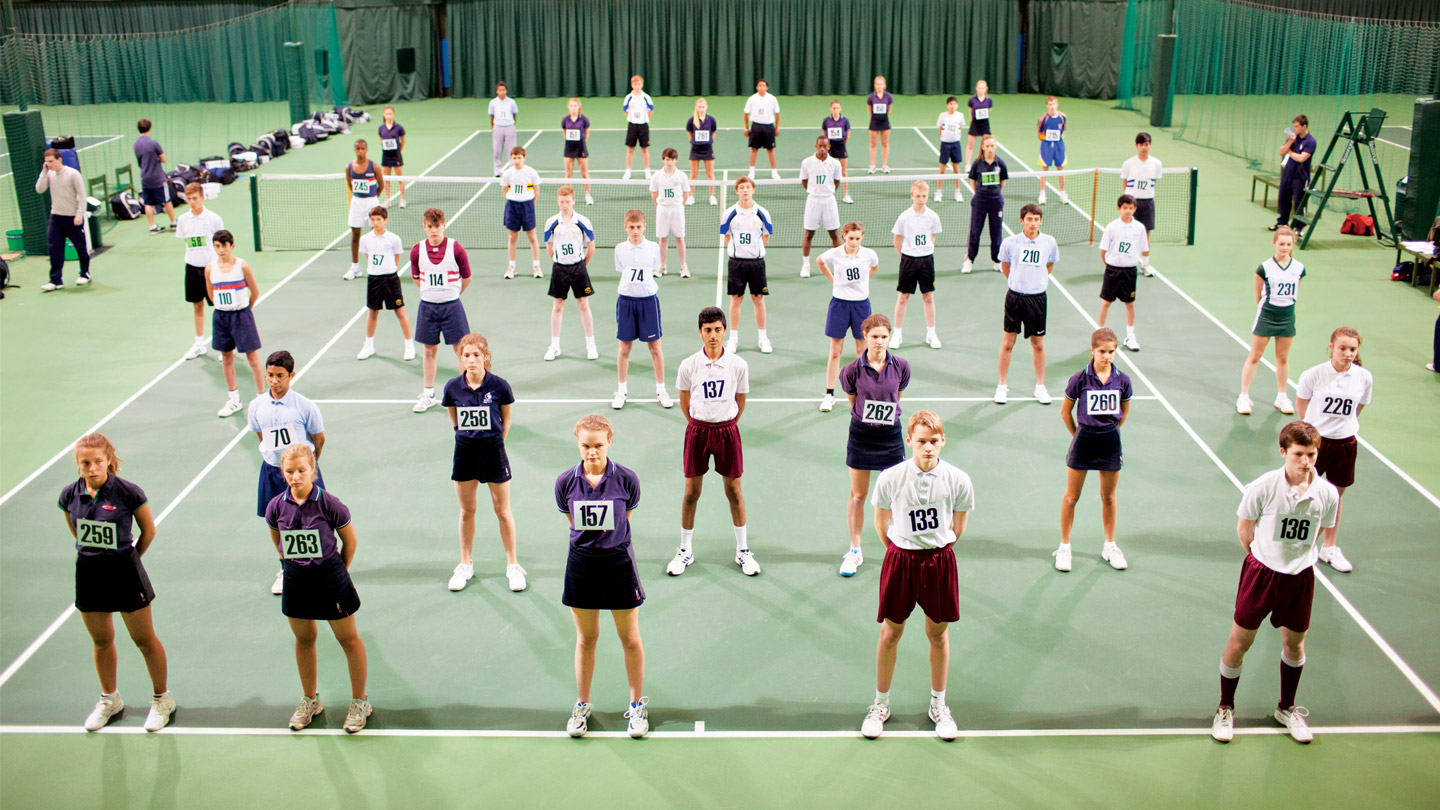In the back seat of his father’s Packard, Bill Thorpe thought he was passing through just another town. On a nation-wide lecture circuit in 1938, starting from their home in Hawthorne, Calif., the Thorpe family had driven past countless gridirons, diamonds and arenas where the legendary Jim Thorpe, Bill’s father, had competed. Between the stops, where Jim spoke about his athletic feats and his Native American culture, he took time to share memories with Bill and his brother, Carl. And so it was that, pulled over by the side of State Route 37 in the town of La Rue, Ohio, Bill first heard about the Oorang Indians.
As the three Thorpe men stepped out of the car on that summer morning, 10-year-old Bill noticed his father seemed lost in thought. “I can remember many days here,” Jim said, before setting off around the edge of the field. Bill knew by that point that his father didn’t bother stopping in a town unless it brought back good memories. Time was tight because it was always tough coaxing the rambunctious boys back into the car. After a couple laps, Jim, dressed in slacks and a sport coat that he’d replace with his traditional Native American wardrobe before his next lecture, looked over at his sons with a grin on his face. “They finally got some grass,” he said.
Too small to host a regulation football game, the Oorang Indians’ home field could barely be called a field — fitting because the team based there could barely be called a team. The Indians were a marketing gimmick meant to put on a show and help move a product — purebred Airedale Terriers — and for two NFL seasons, they did just that. In the process, they created what many consider to be pro football’s first routine halftime show and laid the roots for the most famous yearly performance in sports: the Super Bowl halftime show.
The Super Bowl is one of the most-watched single-day sporting events in the world. This year, the Philadelphia Eagles and New England Patriots will play for a global audience that rates north of 100 million. There’s an entire week dedicated to the lead up, with much of the hype bordering on the ridiculous. Thirty-second commercials during the game cost eight figures, with the spots comprising a cottage industry unto themselves. But bigger than the game itself is the halftime show, which attracts the brightest stars in music and has become the ultimate marriage of sports and pop culture. It’s a spectacle that can make or break careers, and make terms like “wardrobe malfunction” synonymous with football. But it all began humbly, nearly 100 years ago, with a racist dog show starring the greatest American athlete in history and designed with one thing in mind — to advertise and sell.

Walter Lingo opened the Oorang Dog Kennels in La Rue in 1912 and by 1920, he was breeding approximately 15,000 dogs a year and serving a customer base that stretched across the globe as far as China. Ty Cobb was a shareholder and celebrities and athletes regularly visited the kennels to join Lingo on hunting expeditions with his famous Oorang Airedales. Lingo’s was, by most measures, a tremendously successful business, but the man who once claimed to have spent a small fortune of $2,000 a month on advertising was always looking for his next “big publicity stunt.”
The idea of forming the Indians was born in 1921, when Thorpe and Pete Calac, who were both playing for the NFL franchise in nearby Cleveland, paid a visit to La Rue. Out hunting with them one day, Lingo put forward the prospect of buying a football team to promote his kennels. At 33, Thorpe was past his physical prime, but his résumé alone was enough to attract fans.
King Gustav of Sweden had declared Jim Thorpe the “Greatest Athlete on Earth” at the 1912 Olympics; in 1913, the New York Giants had signed him to a record-breaking professional baseball contract despite their manager never having seen him play; in pro football, the Canton Bulldogs had hired him as a player coach for $250 a week, prompting predictions the team would go bankrupt. Instead they attracted 14,000 fans across his first two games — well above their average of 1,200 per contest. Lingo believed Thorpe could generate those same kinds of attendance numbers for him and was willing to pay handsomely. He offered Thorpe $500 a week to be the player-coach of an all-Native American team, as well as his kennel supervisor. Thorpe agreed and the next year Lingo bought the team that would become the Oorang Indians for $100. La Rue, which had less than 1,000 residents at the time, is still the smallest town to ever host an NFL franchise.
In 1922, when Lingo purchased the Indians, professional football’s popularity ranked a distant second to the college game, which had many of the nation’s biggest stars along with a level of pageantry the pro game still lacked. Travelling squads were common, and the Indians, with their mud-caked, non-regulation field, would have to trek 15 miles to Marion, Ohio just to play their home games, where they only played twice. The on-field product was also a fair bit different from the one we know today: The games were low-scoring, playing both sides of the ball was the norm, passing was a last resort and punting on third down was a common strategy to pin opposing teams in their own territory. Also hurting the game’s popularity was the amount of “dead time in between halves,” says Robert Lingo, Walter’s son.
Before the Oorang Indians could hit the field and start advertising Lingo’s dogs, they needed players. Thorpe, who was raised as a member of the Sac and Fox Nation, had attended the Carlisle Indian Industrial School, the first Native American residential boarding school, and starred for the football team there, leading it to wins over powerhouses like Harvard. He began his recruiting push with his old Carlisle teammates. He also targeted former players from the Haskell Institute, which he’d attended before Carlisle, and from the Sherman Institute in California. The Indians would ultimately field an all-Native American roster — the only one in pro football history — for the 1922 season, featuring 25 men from at least nine tribes including Calac and future Hall of Famers Thorpe and Joe Guyon. Lingo also asked the men to double as kennel workers.

Thorpe and his teammates “bonded quite a bit,” says his son, Bill. “They were friendships he had a lot of respect for — ones that lasted.” Herman Downwind, the grandson of Indians player Xavier Downwind, says his grandfather believed hitting the field with Thorpe was an honour. It was a chance for Downwind to play with his “buddies,” Herman says, and to make his community proud. While the school slogan at Carlisle was “Kill the Indian, Save the Man,” under Thorpe, players got to follow a coach who treated them as equals while earning a decent wage. They also found themselves playing for an owner, in Lingo, who was interested in Native American culture and had learned several indigenous dialects.
Still, life in La Rue was hardly free from prejudice. Native Americans were still two years away from officially being recognized as U.S. citizens, let alone being seen as equals. Many of the white people living in La Rue had never even seen a Native American before the players arrived in 1922, explains Jim Anderson, a historian who’s been gathering information on the Oorang Indians for more than 30 years. The team was initially perceived as a bunch of “wild Indians,” a view that was both racist and uninformed. Thorpe’s team was “more educated and a little bit more refined than the average ‘La Ruian’ was at the time,” Anderson says. One of the players, Ted St. Germaine, had earned his law degree in 1913 and eventually became the first Native American admitted to the bar in Wisconsin.
The players may not have fit the common stereotypes about Native Americans, but that didn’t stop Lingo from capitalizing on them to drum up publicity for his dogs. He gave players nicknames like “Baptist Thunder” and “Dick Deer Slayer,” and hired a PR person to travel a day or two ahead of the team to lean into the angle that a horde of wild men was headed to town. A Marion Star headline from 1922 provides an example of the stories that resulted: “Jim Thorpe Has Been Whetting Scalping Knife. Palefaces from Columbus Will Be Burned Alive in Football Parlance – Maybe.”
Wild West shows were very popular at the time, and Lingo and Thorpe believed that playing to those “cowboys and Indians” stereotypes attracted crowds. He applied that theory to the “dead time” problem. Before the game or at intervals during play, Oorang players or groups of other artists would perform traditional indigenous dances. “My father would join them,” says Bill Thorpe. “Taking part in an Indian dance was always a pleasure [for him].”
At halftime, the Oorang Indians would take the field with Lingo’s Oorang Airedale Terriers, the prized breed for which both the kennel and team were named. After walking around the field in a display reminiscent of the Westminster Dog Show, the players would engage in shooting exhibitions and throw tomahawks, knives and lariats at targets that the Airedales would fetch. The dogs’ retrieving skills would be followed by displays of their trailing and treeing abilities while they chased racoons and the kennel’s resident black bear up fake trees to show off their hunting skills. A 1981 edition of The Coffin Corner, the official magazine of the Professional Football Researchers Association, says that, on occasion, Nick Lassa, who played for the Indians under the name “Long Time Sleep,” wrestled the bear.
The show’s grand finale featured Oorang players staging World War I reenactments. Dressed as U.S. Indian Scouts they fought German impersonators, in the process demonstrating how Lingo’s Red Cross Airedales, which sold for as much as $500, could aid wounded soldiers. Some of the players, Calac included, had actually served in the war, a fact Lingo noted in his promotional catalogues. He even claimed some of his dogs were veterans. “We’re entertainment, we’re something to look at, we’re objects, like a piece of art,” says Bill Winneshiek of the message events like the Oorang halftime show sent about Native Americans and whose grandfather, William, played on the team . “It was kind of belittling and demeaning, but you had to do what you had to do to make money.”

Herman Downwind says his grandfather rarely spoke about the pain and oppression he endured as a “second-class citizen,” but did tell him about the racial slurs yelled at both the Oorang Indians and the Carlisle football team. Bill Thorpe says that his father wasn’t deaf to the abuse, “but he was an individual who would always consider the source … If he took offence to all the things that were said [to him], he [would have been] in fights all day long, I’m sure.”
What did drive Thorpe crazy, though, was disappointing results. “He couldn’t stand losing,” says Bill. “He wanted them to be proudly represented on the field — losing [in his opinion] wasn’t good for the Native identity.”
Going into the 1922 season, teams around the league thought the Indians were a squad to be reckoned with. They had size and ran through rigorous workouts, including what may have been the NFL’s first training camp. But with an older lineup, a grueling travel schedule, a total lack of home-field advantage and the fact that while their opponents were catching their breath at halftime, the Indians were busy putting on a show to sell dogs and entertain the fans, the deck wasn’t exactly stacked in their favour. In two seasons of play, they posted a record of 4-16 against NFL competition and 3-2 in non-league contests. Their aging star and main attraction, Thorpe, didn’t play at all in the majority of their games.

It’s probably rare for a team with a .280 winning percentage to be called a success, but the Oorang Indians undoubtedly accomplished Lingo’s goal. According to statistics from newspaper reports gathered by Chris Willis, head researcher at NFL Films and the author of a book on the Indians, the NFL averaged 2,537 fans per game in 1922 and 2,870 fans the following season. The Oorang Indians averaged 3,188, and drew a crowd of more than 4,000 on 11 different occasions.
It’s also hard to imagine a 7-18 team creating a legacy that would still be thriving almost a century later. While the University of Illinois marching band is credited with performing the first collegiate halftime show in 1907, and Robert Lingo freely admits his father drew inspiration from watching marching bands perform at the college level and at county fairs, by the 1920s they were still a rarity. Lingo may have been a product of his time when it came to his willingness to exploit Native Americans, but he was ahead of it in identifying the value of a halftime show for attracting casual fans.
In 2017, headlined by six-time Grammy-winner Lady Gaga, the Super Bowl halftime show had more viewers than the game itself. That may again be the case this year when Justin Timberlake takes the stage. And it may have been the case even without the trailblazing work of La Rue, Ohio’s only professional football team. But thanks to Thorpe, the Oorang Indians, Lingo and his dogs, we’ll never have to find out.





